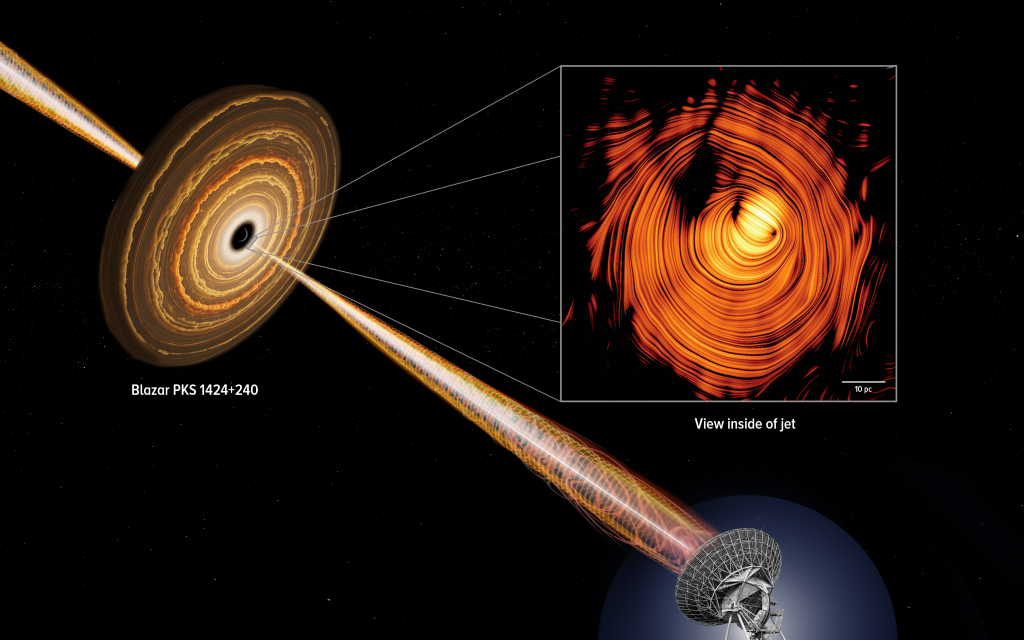The U.S. National Science Foundation National Radio Astronomy Observatory (NSF NRAO), in partnership with several leading Mexican universities and research institutes, has announced a series of landmark agreements and meetings aimed at advancing Mexico’s role in the Next Generation Very Large Array (ngVLA) project.
Recent News
Astronomers Discover a Superheated Star Factory in the Early Universe
Astronomers have uncovered a previously unknown, extreme kind of star factory by taking the temperature of a distant galaxy using the ALMA telescope. The galaxy is glowing intensely in superheated cosmic dust while forming stars 180 times faster than our own Milky Way.
Astronomers Share Largest Molecular Survey To-date: GOTHAM Legacy Data Goes Public
Astronomers in the “GBT Observations of TMC-1: Hunting Aromatic Molecules” research survey, known as GOTHAM, have released a spectral line survey with largest amount of telescope time ever conducted, charting more than 100 molecular species only found in deep space.
NSF VLBA Peers Into the “Eye of Sauron” to Solve Cosmic Neutrino Mystery

Unprecedented radio observations reveal why a distant blazar appears sluggish yet blazes in high-energy gamma rays and neutrinos
Using the U.S. National Science Foundation National Radio Astronomy’s Very Long Baseline Array (NSF NRAO VLBA), an international team of astronomers has solved a decade-long puzzle about one of the brightest cosmic neutrino sources in the sky. Their findings, published today in Astronomy & Astrophysics Letters, reveal that the blazar PKS 1424+240 – dubbed the “Eye of Sauron” for its striking appearance – points its powerful jet almost directly at Earth, creating an extreme cosmic lighthouse effect.
Located billions of light-years away, PKS 1424+240 had long baffled astronomers. Despite appearing to have a slow-moving plasma jet in radio observations, it blazes as one of the brightest sources of high-energy gamma rays and cosmic neutrinos ever detected. This contradiction, known as the “Doppler factor crisis,” has challenged scientists’ understanding of how these extreme cosmic accelerators work.
“The NSF VLBA’s extraordinary resolution has allowed us to peer directly into the heart of this cosmic monster,” said Yuri Kovalev, lead author of the study and Principal Investigator of the ERC-funded MuSES project at the Max Planck Institute for Radio Astronomy. “We discovered that this blazar’s jet is aimed at us with pinpoint precision – within just 0.6 degrees of our line of sight.”
The breakthrough came from 15 years of ultra-high-resolution observations using the NSF VLBA, which consists of ten 25-meter radio telescopes stretching from Hawaii to the U.S. Virgin Islands. By combining 42 separate images collected from 2009 to 2025 as part of the MOJAVE (Monitoring Of Jets in Active galactic nuclei with VLBA Experiments) program, the team created an unprecedented deep view of the blazar’s inner structure.
“This is like looking at car headlights from the Moon – the NSF VLBA’s incredible precision made it possible,” said Jack Livingston, a co-author at the Max Planck Institute for Radio Astronomy. “What we found was a nearly perfect toroidal magnetic field structure threading the jet of plasma,” added Daniel Homan, co-author and professor of Denison University. Alexander Plavin, co-author and research fellow of Harvard University, continued, “It’s creating what looks remarkably like the Eye of Sauron from Tolkien’s Lord of the Rings.”
The extreme alignment of PKS 1424+240’s jet toward Earth creates a relativistic “searchlight” effect, amplifying its brightness by a factor of 30 or more through special relativity. This explains why the source appears as one of the brightest neutrino emitters detected by the IceCube Neutrino Observatory in Antarctica, despite its plasma jet appearing to move slowly in radio images.
The discovery demonstrates the critical role of Very Long Baseline Interferometry (VLBI) in solving cosmic mysteries. The NSF VLBA connects radio telescopes across a continent-sized baseline, creating a virtual telescope with the highest resolution available in astronomy – sharp enough to read a newspaper in New York from Los Angeles.
The research strengthens the connection between relativistic plasma jets, high-energy neutrinos, and the magnetic fields that shape cosmic particle accelerators, marking a significant milestone in multimessenger astronomy – the study of the universe using multiple types of cosmic signals.
Read the press release from the Max-Planck Institute for Radio Astronomy.
Background Information:
A blazar is a type of active galactic nucleus powered by a supermassive black hole that launches jets of plasma moving at nearly the speed of light. What makes blazars special is their orientation: one of their jets points within about 10 degrees of Earth, making them appear exceptionally bright and allowing scientists to study extreme physical processes.
The original paper:
- Y. Kovalev, A. B. Pushkarev, J. L. Gomez, D. C. Homan, M. L. Lister, J. D. Livingston, I. N. Pashchenko, A. V. Plavin, T. Savolainen, S. V. Troitsky: Looking into the Jet Cone of the Neutrino-Associated Very High Energy Blazar PKS 1424+240, A&A Letters, August 12, 2025 (DOI: 10.1051/0004-6361/202555400) https://doi.org/10.1051/0004-6361/202555400
Additional Information/Links
Multi-messenger Studies of Extragalactic Super-colliders (MuSES), ERC Grant
Monitoring Of Jets in Active galactic nuclei with VLBA Experiments (MOJAVE) program
Max Planck Institute for Radio Astronomy (MPIfR)
Center for Astrophysics – Harvard & Smithsonian (CFA)
Very Long Baseline Array (VLBA)
European Research Council (ERC)
About NRAO
The U.S. National Radio Astronomy Observatory is a facility of the National Science Foundation, operated under cooperative agreement by Associated Universities, Inc.
About the VLBA
The NSF Very Long Baseline Array is a system of ten identical 25-meter radio telescopes operating as a single instrument. Stretching 5,000 miles from Mauna Kea, Hawaii, to St. Croix in the U.S. Virgin Islands, the VLBA provides the highest resolution images available in astronomy.
Visit the NRAO weibsite for images and additional resources.
This news article was originally published on the NRAO website on August 12, 2025.
Recent News
NSF National Radio Astronomy Observatory and Mexican Institutions Sign Historic Agreements to Advance ngVLA Collaboration
The U.S. National Science Foundation National Radio Astronomy Observatory (NSF NRAO), in partnership with several leading Mexican universities and research institutes, has announced a series of landmark agreements and meetings aimed at advancing Mexico’s role in the Next Generation Very Large Array (ngVLA) project.
Astronomers Discover a Superheated Star Factory in the Early Universe
Astronomers have uncovered a previously unknown, extreme kind of star factory by taking the temperature of a distant galaxy using the ALMA telescope. The galaxy is glowing intensely in superheated cosmic dust while forming stars 180 times faster than our own Milky Way.
Astronomers Share Largest Molecular Survey To-date: GOTHAM Legacy Data Goes Public
Astronomers in the “GBT Observations of TMC-1: Hunting Aromatic Molecules” research survey, known as GOTHAM, have released a spectral line survey with largest amount of telescope time ever conducted, charting more than 100 molecular species only found in deep space.
